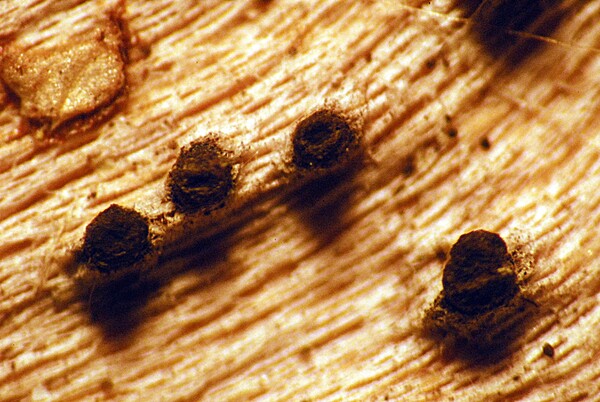Pyrgidium montellicum (Beltr.) Tibell
Lichenologist, 14: 239, 1982. Basionym: Acolium montellicum Beltr. - Lich. Bassan.: 285, 1858.
Synonyms:
Distribution: N - Ven (Nascimbene & Marini 2010).
Description: Thallus crustose, thinly episubstratic, continuous and farinose, whitish, very pale straw-yellow to yellowish grey, doubtfully lichenized. Apothecia sessile to shortly stalked, 0.13-0.29 mm high and 0.16-0.33 mm wide, almost spherical to ovoid, without a thalline margin. Mazaedium black, filling the apothecial cavity and more or less projecting above the excipular margin. Proper exciple prosoplectenchymatous, dark brown, (10-)22-32(-55) µm thick laterally, gradually attenuating towards the margin, (27-)40-80(-90) µm thick at base; paraphyses 0.4-2 µm thick, septate, unbranched. Asci 8-spored, cylindrical, unitunicate, short pedicellate, persisting almost until the spores have reached full maturity, blunt-tipped, not narrowing towards the apex, which is at first thickened, later reduced or inconspicuous, with uniseriately arranged spores. Ascospores 1-septate, pale to dark brown, broadly ellipsoid to oval, (4-)5.5-6.5(-10) x (2-)3-3.5(-5) µm, with a minute ornamentation of short, irregular, longitudinally arranged ridges. Photobiont absent (sometimes the thallus is loosely associated with mainly trentepohlioid algae). Spot tests: K-, C-, KC-, P-, UV-. Chemistry: without lichen substances.Note: a mainly tropical species described from Northern Italy (the only European record), where it is probably extinct. The hitherto known distribution includes Italy, India, Colombia, and Costa Rica. It is included as “Regionally Extinct” in the Italian red list of epiphytic lichens (Nascimbene & al. 2013c).
Growth form: Fungus
Substrata: bark
Reproductive strategy: mainly sexual
Restricted to humid-warm, oceanic areas
Commonnes-rarity: (info)
Alpine belt: absent
Subalpine belt: absent
Oromediterranean belt: absent
Montane belt: absent
Submediterranean belt: extremely rare
Padanian area: absent
Humid submediterranean belt: extremely rare
Humid mediterranean belt: absent
Dry mediterranean belt: absent
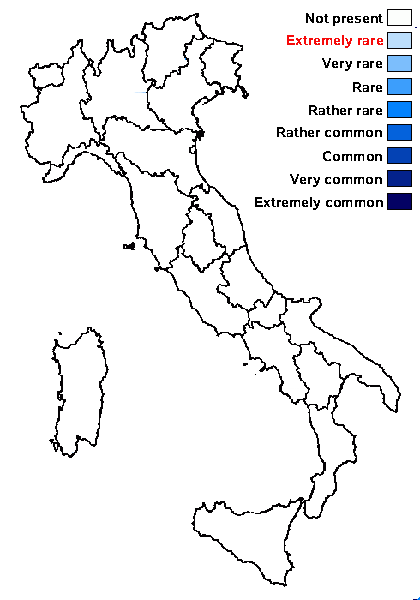
Predictive model
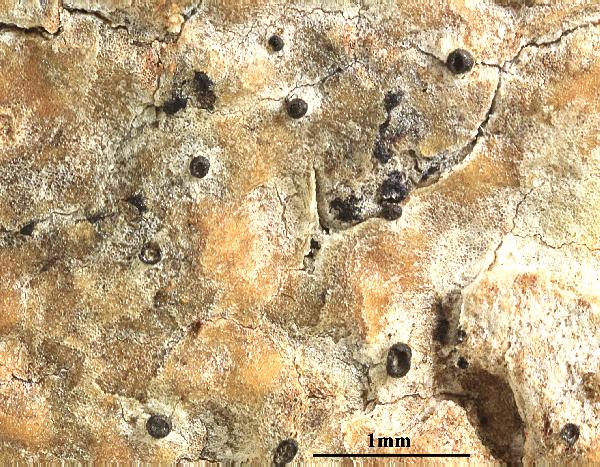

Felix Schumm - CC BY-SA 4.0
[ABL11449], Brazil, Rondônia, Porto Velho, Parque Circuito. 8°43'54''
S, 63°54'04'' W, 100 m. On Hevea brasiliensis bark in plantation. Leg.
M. Cáceres & A. Aptroot, (no. 11449), 11 March 1012, det. A. Aptroot
2012.


Felix Schumm - CC BY-SA 4.0
[ABL11449], Brazil, Rondônia, Porto Velho, Parque Circuito. 8°43'54''
S, 63°54'04'' W, 100 m. On Hevea brasiliensis bark in plantation. Leg.
M. Cáceres & A. Aptroot, (no. 11449), 11 March 1012, det. A. Aptroot
2012.
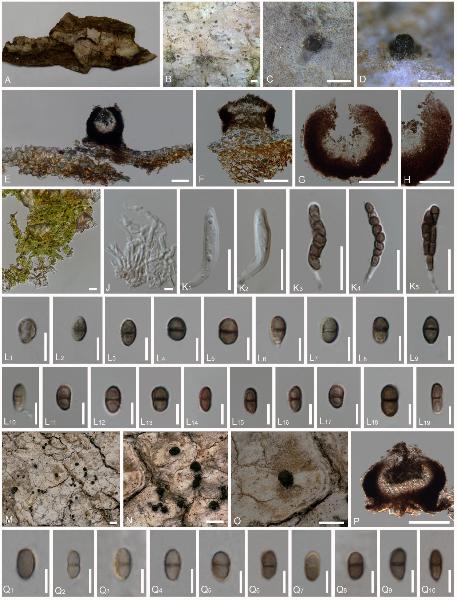
Source: Thiyagaraja, V.; Ertz, D.; Lücking, R.; Wanasinghe, D.N.; Aptroot, A.; Cáceres, M.E.d.S.; Hyde, K.D.; Tapingkae, W.; Cheewangkoon, R. Taxonomic and Phylogenetic Reassessment of Pyrgidium (Mycocaliciales) and Investigation of Ascospore Morphology. J. Fungi 2022, 8, 966. https://doi.org/10.3390/jof8090966 - CC BY 4.0
Pyrgidium montellicum (Thailand: MFLU 21-0135, Brazil: Cáceres and Aptroot 11449), (A–D). Ascomata on substrate (MFLU 21-0135), (E–G). Vertical section through the ascoma (MFLU 21-0135), (H). Vertical section through the exciple (MFLU 21-0135), (I). Loosely associated algae (MFLU 21-0135), (J). Paraphyses (MFLU 21-0135), (K1–K5). Asci (MFLU 21-0135), (L1–L10). Ascospores in water (MFLU 21-0135), (L11–L19). Ascospores in 5% KOH (MFLU 21-0135), (M–O). Ascomata on substrate (Cáceres & Aptroot 11449), (P). Vertical section through the ascoma (Cáceres and Aptroot 11449). (Q1–Q10). Ascospores in water (Cáceres and Aptroot 11449). Scale bars: (B–D), (M–O) = 500 μm, (C,D) = 200 μm, (E–G), (P) = 100 μm, (H) = 50 μm, (I) = 10 μm, (J) = 5 μm, (K1–K5) = 20 μm, (L1) = 10 μm, (L2–L19), (Q1–Q10) = 5 μm.
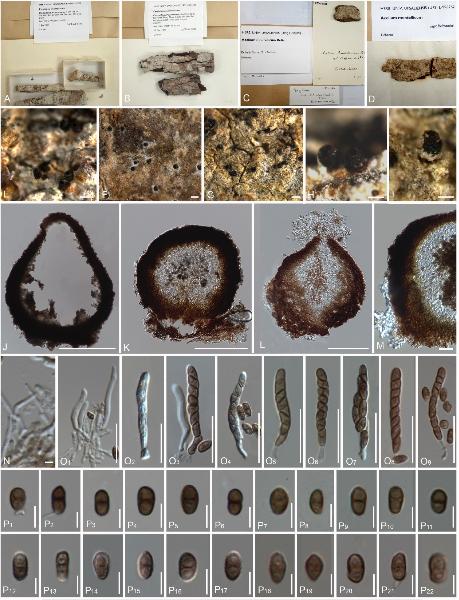
Source: Thiyagaraja, V.; Ertz, D.; Lücking, R.; Wanasinghe, D.N.; Aptroot, A.; Cáceres, M.E.d.S.; Hyde, K.D.; Tapingkae, W.; Cheewangkoon, R. Taxonomic and Phylogenetic Reassessment of Pyrgidium (Mycocaliciales) and Investigation of Ascospore Morphology. J. Fungi 2022, 8, 966. https://doi.org/10.3390/jof8090966 - CC BY 4.0
Pyrgidium montellicum (type materials of Acolium montellicum (L-008798, L-996762) and non-type materials of P. montellicum (Tibell 8306, Tibell 8232)), (A–D). Details of herbarium specimens (A). Tibell 8306, (B). Tibell 8232, (C). L-008798, (D). L-996762, (E–I). Ascomata on substrate (E,H). Tibell 8306, (F). Tibell 8232, (G,I). L-008798, (J–L). Vertical section through the exciple, (J). Tibell 8306, (K). Tibell 8232, (L). L-996762, (M). Tibell 8232, (N). L-996762, (O1–O9). Asci, (O1–O4,O7). L-996762, (O5,O6). L-008798, (O8,O9). Tibell 8232. Ascospores ((P1–P22), (P1–P6). Tibell 8306, (P7–P8). L-008798, (P12–P16). 1981 L-996762, (P17–P22). Tibell 8232)). Scale bars: (E,F) = 1000 μm, (G,H) = 500 μm, (J–L) = 100 μm, (M) = 20 μm, (K) = 5 μm, (O1–O9) = 20 μm, (P1–P22) = 5 μm.
Growth form: Fungus
Substrata: bark
Reproductive strategy: mainly sexual
Restricted to humid-warm, oceanic areas
Commonnes-rarity: (info)
Alpine belt: absent
Subalpine belt: absent
Oromediterranean belt: absent
Montane belt: absent
Submediterranean belt: extremely rare
Padanian area: absent
Humid submediterranean belt: extremely rare
Humid mediterranean belt: absent
Dry mediterranean belt: absent

Predictive model


Felix Schumm - CC BY-SA 4.0
[ABL11449], Brazil, Rondônia, Porto Velho, Parque Circuito. 8°43'54'' S, 63°54'04'' W, 100 m. On Hevea brasiliensis bark in plantation. Leg. M. Cáceres & A. Aptroot, (no. 11449), 11 March 1012, det. A. Aptroot 2012.


Felix Schumm - CC BY-SA 4.0
[ABL11449], Brazil, Rondônia, Porto Velho, Parque Circuito. 8°43'54'' S, 63°54'04'' W, 100 m. On Hevea brasiliensis bark in plantation. Leg. M. Cáceres & A. Aptroot, (no. 11449), 11 March 1012, det. A. Aptroot 2012.

Source: Thiyagaraja, V.; Ertz, D.; Lücking, R.; Wanasinghe, D.N.; Aptroot, A.; Cáceres, M.E.d.S.; Hyde, K.D.; Tapingkae, W.; Cheewangkoon, R. Taxonomic and Phylogenetic Reassessment of Pyrgidium (Mycocaliciales) and Investigation of Ascospore Morphology. J. Fungi 2022, 8, 966. https://doi.org/10.3390/jof8090966 - CC BY 4.0
Pyrgidium montellicum (Thailand: MFLU 21-0135, Brazil: Cáceres and Aptroot 11449), (A–D). Ascomata on substrate (MFLU 21-0135), (E–G). Vertical section through the ascoma (MFLU 21-0135), (H). Vertical section through the exciple (MFLU 21-0135), (I). Loosely associated algae (MFLU 21-0135), (J). Paraphyses (MFLU 21-0135), (K1–K5). Asci (MFLU 21-0135), (L1–L10). Ascospores in water (MFLU 21-0135), (L11–L19). Ascospores in 5% KOH (MFLU 21-0135), (M–O). Ascomata on substrate (Cáceres & Aptroot 11449), (P). Vertical section through the ascoma (Cáceres and Aptroot 11449). (Q1–Q10). Ascospores in water (Cáceres and Aptroot 11449). Scale bars: (B–D), (M–O) = 500 μm, (C,D) = 200 μm, (E–G), (P) = 100 μm, (H) = 50 μm, (I) = 10 μm, (J) = 5 μm, (K1–K5) = 20 μm, (L1) = 10 μm, (L2–L19), (Q1–Q10) = 5 μm.

 INDEX FUNGORUM
INDEX FUNGORUM
 GBIF
GBIF
 DOLICHENS
DOLICHENS

